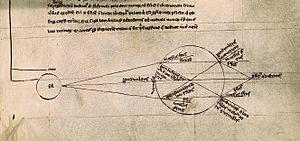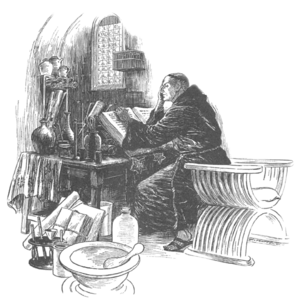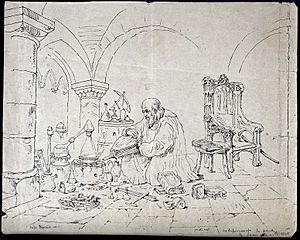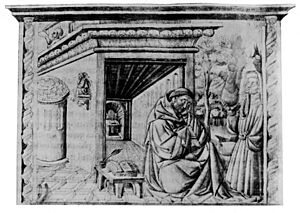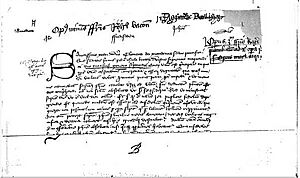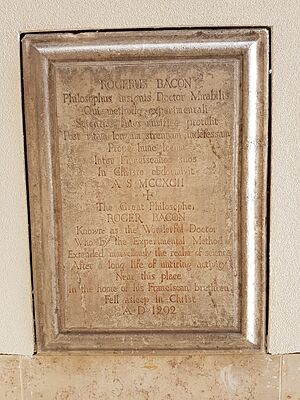Roger Bacon facts for kids
Quick facts for kids
Roger Bacon
OFM
|
|
|---|---|
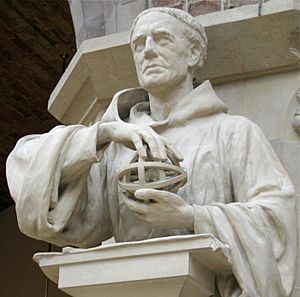 |
|
| Born | c. 1219/20 Near Ilchester, Somerset, England
|
| Died | c. 1292 (aged about 72/73) Near Oxford, Oxfordshire, England
|
| Nationality | English |
| Other names | Doctor Mirabilis |
| Alma mater | University of Oxford |
| Era | Medieval philosophy |
| Region | Western philosophy |
| School | Scholasticism |
|
Main interests
|
Theology Natural philosophy |
|
Notable ideas
|
Experimental science |
|
Influences
|
|
Roger Bacon (/ˈbeɪkən/; Latin: Rogerus or Rogerius Baconus, Baconis, also Frater Rogerus; c. 1219/20 – c. 1292) was an English philosopher and Franciscan friar who lived in the Middle Ages. He was known as Doctor Mirabilis, which means "Wonderful Teacher".
Bacon believed it was very important to study nature by observing things and doing experiments. He is sometimes seen as one of the first Europeans to support the modern scientific method. He used the method of Ibn al-Haytham to study what Aristotle had written. Bacon found that his own experiments sometimes showed different results than what Aristotle had predicted.
He also thought that understanding languages was very important. Later on, people in the early modern era even thought he was a wizard! He was famous for a story about a mechanical "brazen head" that could speak.
Contents
Life of Roger Bacon
Roger Bacon was born in Ilchester, England, around 1220. His family was quite wealthy.
He studied at Oxford University. Even though his teacher Robert Grosseteste had left, his ideas still influenced Bacon. Bacon became a Master at Oxford, teaching about Aristotle. He was never officially given a doctorate degree. The name Doctor Mirabilis was given to him after he died.
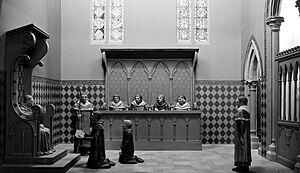
Around 1237, he went to teach at the University of Paris. There, he taught about Latin grammar, logic, math, geometry, astronomy, and music. He left Paris around 1247.
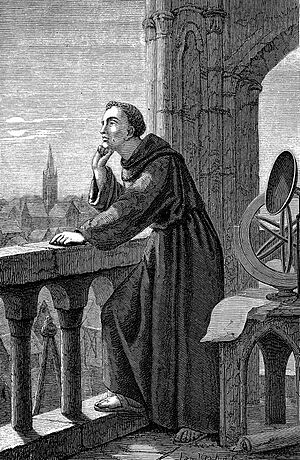
For the next ten years, he was a private scholar. He likely spent time in Oxford and Paris. He studied many Greek and Arabic books about optics, which was then called "perspective."
Around 1256, he became a friar in the Franciscan Order. After 1260, he was not allowed to publish books without permission from his superiors. This made it hard for him to do his scholarly work.
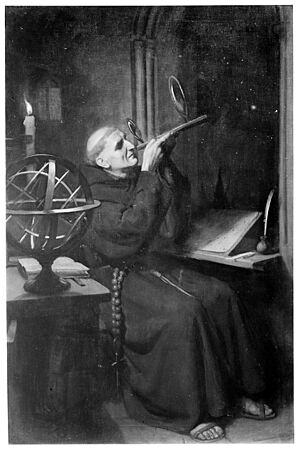
In the mid-1260s, he looked for people who could help him get permission and money to return to Oxford. He found a friend in Guy de Foulques, who later became Pope Clement IV.
Pope Clement IV asked Bacon to write about "writings and remedies for current conditions." In 1267, Bacon sent the Pope his most important work, the Opus Majus. This book shared his ideas on how to combine Aristotelian logic and science with theology.
Bacon also sent other works to the Pope, including Opus Minus and De Multiplicatione Specierum. He wrote about a million words in about a year!
Pope Clement IV died in 1268, and Bacon lost his supporter. Some time after this, Bacon was likely put in prison or under house arrest. This was possibly because of his "new ideas" or his strong personality.
After 1278, Bacon returned to the Franciscan House in Oxford. He continued his studies there. His last known writing was in 1292. He probably died soon after and was buried in Oxford.
Roger Bacon's Writings
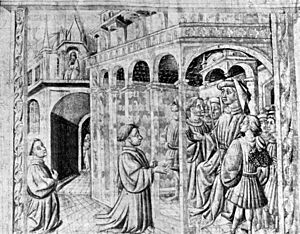
In medieval Europe, philosophers often relied on old texts and translations. By the 1200s, new works from Muslim Spain began to arrive. Roger Bacon believed in collecting facts before deciding on scientific truths. He said this would bring "quiet to the mind."
Bacon also wanted to change how theology was taught. He thought theologians should focus on the Bible itself and learn its original languages. He knew several languages and saw mistakes in translations. He also believed that theologians should study science.
The Opus Majus
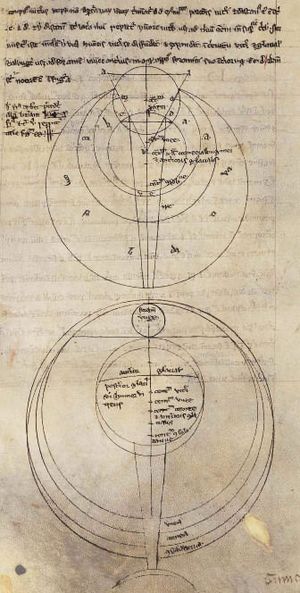
Bacon's Greater Work, the Opus Majus, was written in 1267. It talks about mathematics, optics, alchemy, and astronomy. It even included ideas about the positions and sizes of planets and stars.
The book was a huge proposal to change what was taught at universities. He wanted to add subjects like optics, astronomy (including astrology and geography), mechanics, alchemy, agriculture, medicine, and "experimental science."
Bacon criticized some scholars of his time who only knew about Aristotle from second-hand information. He respected Islamic thinkers, calling them "both philosophers and sacred writers." He believed their ideas should be part of Christian learning.
Calendar Reform Ideas
In the Opus Majus, Bacon suggested changes to the calendar. His ideas were similar to the Gregorian calendar that was adopted much later in 1582. He used ancient Greek and medieval Islamic astronomy to show that the old Julian calendar was not accurate enough.
Bacon said that the calculation of Easter had shifted by 9 days since the year 325. He suggested removing one day every 125 years. His ideas were not put into action because Pope Clement IV died.
Optics and Light
In his Opus Majus, Bacon wrote about how our eyes see and how the eye and brain work. He studied light, distance, and how we see things directly or through reflection. He also looked at refraction (how light bends), mirrors, and lenses. His work was heavily influenced by the book Book of Optics by Alhazen.
Gunpowder Discoveries
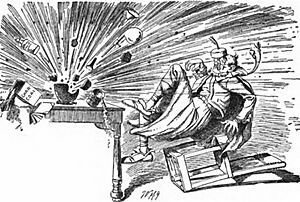
Roger Bacon is often credited with being the first in Europe to write down the formula for gunpowder. Gunpowder was actually invented in China first. It's thought that Bacon might have seen Chinese firecrackers, possibly brought back by Franciscans who visited the Mongol Empire.
Some people in the early 1900s thought Bacon had hidden the gunpowder recipe in a secret code in one of his letters. However, later studies showed that this secret message was not from Bacon. Also, the proportions in the supposed recipe would not even work well for firecrackers.
Alchemy and Hidden Knowledge
Bacon is linked to several texts about alchemy. Alchemy was an old practice that tried to turn common metals into gold and find a way to live forever.
One letter, On the Wonderful Powers of Art and Nature, is thought to be falsely credited to Bacon. It talks about alchemy, including a recipe for a philosopher's stone. It also mentions ideas for flying machines and submarines, saying Alexander the Great used them first! This letter also tries to explain magic through natural events.
Bacon believed that alchemy was a very important science. He thought that science could help explain spiritual ideas. He kept his writings on alchemy a bit vague, possibly because of the need for secrecy about such topics in England at the time.
Language Studies
Bacon wrote several books about language and logic. In his books on Greek and Hebrew grammar, and in his Opus Majus, Bacon emphasized that scholars needed to know several languages. He was interested in the languages of science and religion: Arabic, Greek, Hebrew, and Latin.
He wanted to understand the rules of these languages so that Latin readers would not misunderstand old texts. He said, "I want to describe Greek grammar for the benefit of Latin speakers." He even claimed he could teach someone a new language in three days!
Bacon also suggested that there is a basic grammar that is the same in all human languages. He wrote: "Grammar is one and the same in all languages, substantially, though it may vary, accidentally, in each of them."
Other Important Works
Bacon's Lesser Work (Opus Minus) and Third Work (Opus Tertium) were meant to be shorter versions of his Opus Majus.
Other writings by Bacon include works on how things multiply, burning lenses, and his "Compendium of the Study of Philosophy" and "of Theology."
Books Not Written by Bacon
Some books were wrongly thought to be written by Roger Bacon.
- The Mirror of Alchimy is a short book about how metals are made. Experts say it doesn't sound like Bacon's writing or ideas.
- The mysterious Voynich manuscript was also thought to be by Bacon by some. But historians say there's no proof, and the paper it's written on is from the 1400s, long after Bacon lived.
Roger Bacon's Legacy

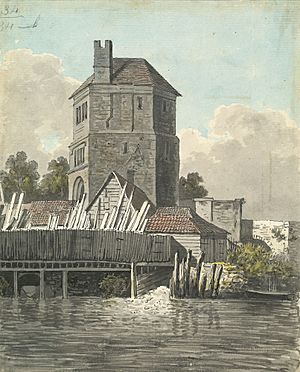
Roger Bacon was not very famous during his own time. But his ideas did influence some scholars. He also helped add optics to university studies.
Later, in the early modern period, English people saw him as a wise magician who knew "forbidden knowledge." One popular legend was that he made a talking brass head that could answer any question. This story appeared in a 16th-century book and a play by Robert Greene. In the play, the head says "Time is," "Time was," and "Time is Past" before being destroyed.
Some people thought this legend came from a misunderstanding of an alchemist's work. It might also be related to Bacon's interest in building clockwork models of the sky.
By the 1800s, many people saw Bacon as a scientific pioneer. They thought he was ahead of his time, like a 16th or 17th-century philosopher living in the 13th century. His ideas about testing theories with experiments were seen as one of the first important steps toward the scientific method.
This view made Bacon seem like a lone genius in a time that didn't understand him. People even thought he predicted inventions like submarines, airplanes, and cars!
However, in the 20th century, historians realized that Bacon was not as alone as once thought. He was influenced by many other medieval scholars, especially Robert Grosseteste. Bacon himself praised other mathematicians and scholars of his time. The medieval church was also not against scientific study.
Today, Roger Bacon is seen as an important figure in the early days of universities in Paris and Oxford. He was part of a group of scholars who helped develop the philosophy of science. Modern studies also highlight his strong commitment to the Franciscan order.
In Oxford, there's a legend that Folly Bridge is named after Bacon because he was under house arrest nearby. This is probably not true, but the bridge was once called "Friar Bacon's Bridge." There is also a plaque in Oxford that honors him.
See also
 In Spanish: Roger Bacon para niños
In Spanish: Roger Bacon para niños
- Baco, a lunar crater named for Roger Bacon
- History of geomagnetism, of translation, of the scientific method, and of science in the Middle Ages
- John of St Amand
- List of Catholic clergy scientists
- Oxford Franciscan school
- Roger Bacon High School
- Vitello
- Wilfrid Voynich





